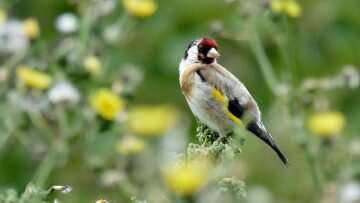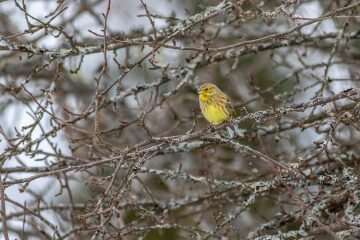European Goldfinch. Credit: Andrea Lightfoot
A new University of British Columbia (UBC)-led study looking into the impacts that large industrial farming has on biodiversity found that increased farm size causes a decline in bird diversity.
"Wildlife is a good indicator of a healthy agroecosystem and one thing we wanted to understand was the link between farm size and biodiversity in surrounding areas," says Frederik Noack, Assistant Professor in the Food and Resource Economics Group, part of UBC's Faculty of Land and Food Systems.
To understand this relationship, the researchers studied how different farming indicators impact the diversity of local birds in the farmland bordering the former Iron Curtain in Germany.
Researchers found that increased farm sizes resulted in a 15 per cent decline in bird diversity.
Although the former inner German border lost its political implications after the German reunification, farms are still five times larger on the eastern side of the border compared to the western side as a legacy of the farm collectivization in the former East Germany.
Farms in the former East Germany have been privatized for 30 years now, but the sharp differences in farm sizes remains along the previous border. This provides an ideal setup to study the impact of farm size on biodiversity in an otherwise ecological and politically similar environment.
A diverse bird population provides natural pest control and maintenance of an overall healthy ecosystem.
"Surprisingly, we found that larger farms are not damaging themselves, but their typical characteristics tend to harm bird diversity," Noack explains. "Larger farms have typically larger fields and create more homogenous landscapes with less diverse bird habitats."
Yellowhammer. Credit: Erik Karits
He says these results suggest that maintaining diverse habitats within the agricultural landscape plays a crucial role for conserving bird diversity.
"Providing a mix of different crop type and other land uses such as forests and grassland within the agricultural landscape is crucial for biodiversity conservation and can mitigate the negative impact of agricultural industrialization," he said.
Noack says that their findings highlight the importance of analyzing the agricultural changes in a landscape context.
The study used a biodiversity database along with citizen science observations, and layered this on top of satellite farm images to make correlations between farm size, crop cover, land cover diversity and land use intensity.
Combining geolocalized bird diversity data from systematic bird surveys and opportunistic citizen science data with high resolution satellite images allowed researchers to study the mechanisms that relate farm size to biodiversity.
"The high resolution land cover data allowed us to characterize the bird habitat for each bird diversity observation including field size, crop type, and land use intensity. Based on our results, we can then provide the information for policies to mitigate the negative impact of agricultural industrialization on biodiversity."
Noack says agri-environmental policies play an important role in harmonizing agricultural intensification with biodiversity conservation targets.
"Our results show that the negative impact of increased farm size can be mitigated by conserving land cover diversity within the agricultural landscape. In practice, this could mean incentivizing riparian buffer strips, forest patches, hedgerows, or agroforestry."
Other researchers involved include Ashley Larsen, Bren School of Environmental Science & Management, University of California, Santa Barbara; Johannes Kamp, Department of Conservation Biology, University of Göttingen, Germany; and Christian Levers, Department of Environmental Geography, Vrije Universiteit Amsterdam, The Netherlands.
More information: Frederik Noack et al, A bird's eye view of farm size and biodiversity: The ecological legacy of the iron curtain, American Journal of Agricultural Economics (2021). DOI: 10.1111/ajae.12274
Provided by University of British Columbia

























